Professional Blood Collection Tube Manufacturer & Supplier
JINYE is a leading manufacturer and supplier of disposable blood collection tubes. Our wide range of blood collection tubes includes EDTA tubes, plain tubes, clot activator tubes, gel & clot activator tubes, glucose tubes, PT tubes, heparin tubes, ESR tubes, serum separation tubes, microliters, and more. With years of experience and a commitment to quality, we provide healthcare professionals with reliable products.
We also focus on effective marketing strategies to meet the needs of our clients. Choose JINYE for trusted blood collection solutions.

Product Overview:
Disposable Blood Collection Tube
Material: Glass & PET
Size: 13*75mm 13*100mm, 16*100mm
Vol: 1-10ml
Types: EDTA Tube/Plain Tube/Serum Tube/Heparin Tube/Glucose Tube/ESR Tube/PT Tube/Gel & Clot Activator Tube
Application: Blood Collection


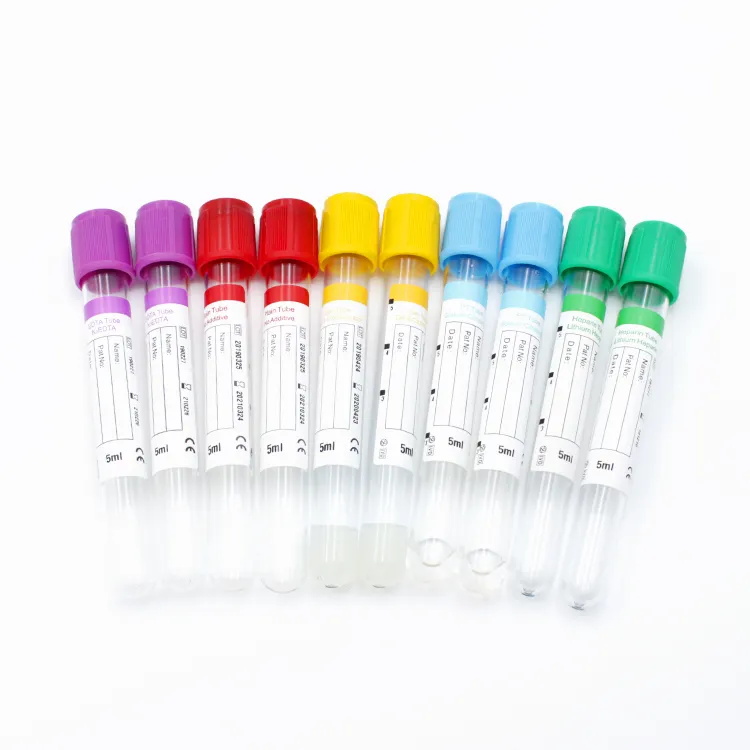
| Category | Tube Name | Additive | Cap Colour | Tube Size(mm)&Draw Volume (mL) | Material |
| Serum Blood Collection Tube | No Additive | No Additive | White | 13×75 1/2/3/4 13×100 5/6 16×100 7/8/9/10 | Glass/Plastic |
| Clot Activator | Clot Activator | Red | 13×75 1/2/3/4 13×100 5/6 16×100 7/8/9/10 | Glass/Plastic | |
| Gel & Clot Activator | Gel & Clot Activator | Yellow | 13×75 1/2/3/4 13×100 5/6 16×100 7/8.5 | Glass/Plastic | |
| Plasma Blood Collection Tube | EDTA& NaF | EDTA& NaF | Grey | 13×75 2/3/4 13×100 5 16×100 | Glass/Plastic |
| Lithium Heparin | Lithium Heparin | Green | 13×75 1/2/3/4 13×100 5/6 16×100 7/8/9/10 | Glass/Plastic | |
| Sodium Heparin | Sodium Heparin | Green | 13×75 1/2/3/4 13×100 5/6 16×100 7/8/9/10 | Glass/Plastic | |
| Sodium Citrate | Sodium Citrate | Blue | 13×75 1.8/2/3/4 13×100 5/6 16×100 7/8 | Glass/Plastic | |
| Whole Blood Collection Tube | K2EDTA | K2 EDTA | Purple | 13×75 1/2/3/4 13×100 5/6 16×100 7/8/9/10 | Glass/Plastic |
| K3EDTA | K3 EDTA | Purple | 13×75 1/2/3/4 13×100 5/6 16×100 7/8/9/10 | Glass/Plastic | |
| ESR | Sodium Citrate | black | 13×75 1.6/2/2.4/3/4 8×120 1.28/1.6 | Glass/Plastic |
Types of Blood Collection Tubes and How to Distinguish Multi-colored Blood Collection Tubes

Red Blood Collection Tube – Regular/Rapid Serum Tube
The red blood collection tube, or a biochemical tube, does not contain anticoagulants. The inner wall of the box is uniformly coated with an anti-coagulant to prevent clotting. It is primarily used for blood biochemistry tests. There are two types: regular and rapid serum tubes, distinguished by labeling indicating the presence of clot activator or by using red and orange caps. The clot activator accelerates blood clotting, making it suitable for obtaining quicker results.
Sample Type: Serum
Applications: Bacterial testing, tumor screening, gonadal hormone assays, routine immunological tests, comprehensive immunological assays, rheumatoid antibody tests, diabetic nephropathy screening, complete blood counts, prostaglandin assays, HBV-DNA testing, ferritin testing, cold agglutination tests, calcitonin testing, chlamydia antibody tests, gastrin testing, ANCA tests, cytomegalovirus antibody tests, human epididymal secretory protein testing, serum protein electrophoresis, RA panel tests, TB-AD tuberculosis antibody tests, and more.
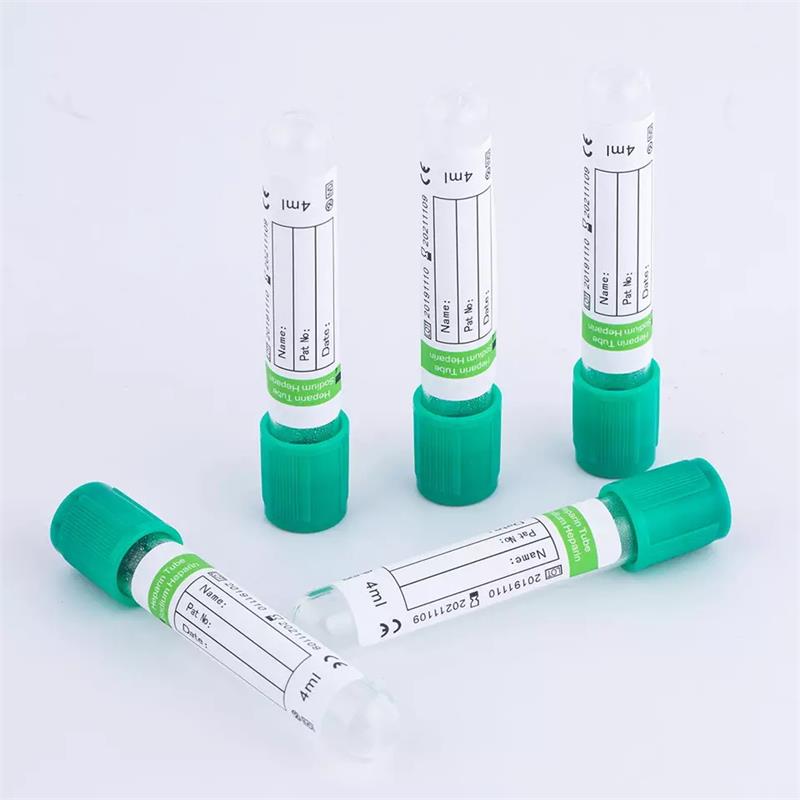
Green Blood Collection Tube – Heparin Anticoagulant Tube
The green blood collection tube contains heparin, a substance with direct anticoagulant properties that extend the coagulation time of the specimen. Excessive heparin can cause white blood cell aggregation, rendering it unsuitable for white blood cell counts. Moreover, it may lead to a pale blue background in blood smears after staining, making it unsuitable for white blood cell classification.
Sample Types: Whole blood, plasma
Applications: Red blood cell fragility tests, blood gas analysis, hematocrit tests, erythrocyte sedimentation rate (ESR) tests, and routine biochemical assays.

Light Green Blood Collection Tube – Plasma Separation Tube
The light green blood collection tube contains lithium heparin or sodium heparin along with a gel separator. Heparin is a polysaccharide with sulfate groups, carrying a strong negative charge. It effectively inhibits the formation of thrombin, inactivating serine proteases. It also prevents platelet aggregation and offers various anticoagulant effects. Typically, 15 IU of heparin anticoagulates 1 ml of blood. Heparin tubes are commonly used for emergency biochemical and hemorheological (blood flow) tests.
Sample Type: Plasma
Applications: Tests for TNT, environmental mycotoxins, B27 antigen, blood ammonia levels, and B-type natriuretic peptide (BNP).

Purple Blood Collection Tube – EDTA Anticoagulant Tube
The purple blood collection tube contains EDTA (Ethylenediaminetetraacetic acid) anticoagulant. Compared to other anticoagulants, EDTA has a minimal impact on blood cell aggregation and morphology in routine blood tests. Therefore, EDTA salts (e.g., K2, K3, or Na2) are commonly used as anticoagulants. EDTA salts can chelate with calcium ions in the blood, preventing blood clotting.
Sample Type: Whole Blood, Plasma
Applications:
2ml Tube: Hematology tests, reticulocyte count, glycosylated hemoglobin (HbA1c), TC blood group, B-type natriuretic peptide (BNP).
5ml Tube: Pituitary function tests, parathyroid hormone, renin, adrenal function, adrenocorticotropic hormone (ATCH) + cortisol (COR), cortisol, blood typing + D antigen (crossmatch).
Not suitable for coagulation tests, platelet function assays, calcium, potassium, sodium, iron, alkaline phosphatase, creatine kinase, and lysyl aminopeptidase measurements, as well as PCR assays.
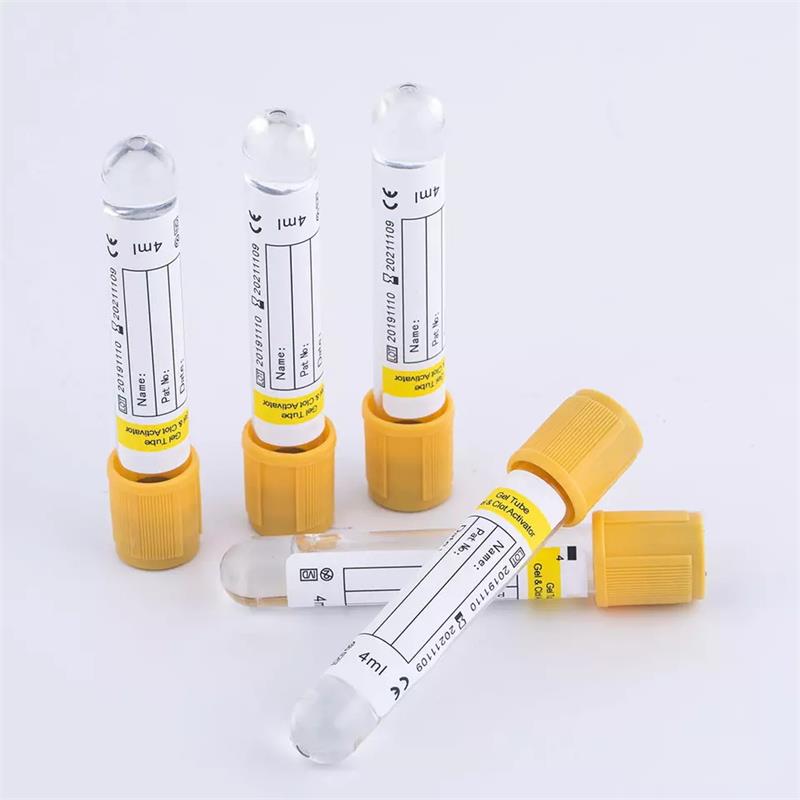
Yellow Blood Collection Tube – Inert Separation Gel with Clot Activator Tube
The yellow blood collection tube contains an inert separation gel and a clot activator. The tube’s inner wall is coated with a clot activator, which accelerates blood coagulation, eliminating the need for a 37℃ water bath and reducing testing time. The separation gel exhibits excellent affinity with PET tubes, serving as an effective barrier.
Sample Type: Serum
Applications:
3ml Tube: Biochemical tests, digoxin concentration, myocardial enzymes, amylase, thyroid function tests (TFT), free thyroxine (FT4), total thyroxine (TT4), thyroid antibody tests, thyroid receptor antibody tests.
5ml Tube: C-reactive protein (CRP) immunoassays (suitable for both serum and plasma), high-sensitivity C-reactive protein (hs-CRP).

Light Blue Blood Collection Tube – Sodium Citrate Tube
The light blue blood collection tube contains 3.2% or 3.8% sodium citrate. When collecting blood, ensure an adequate blood volume to guarantee accurate test results. After blood collection, immediately invert the tube 5-8 times to mix thoroughly. The anticoagulant-to-blood ratio is 1:9.
Sample Type: Whole blood, plasma
Applications:
Used for fibrinolysis system tests, including prothrombin time (PT), activated partial thromboplastin time (aPTT), thrombin time (TT), and fibrinogen testing.

Black Blood Collection Tube – Sodium Citrate ESR Tube
The black blood collection tube contains 3.2% (0.109mol/L) to 3.8% sodium citrate (citric acid sodium salt). The anticoagulant in this tube has a blood-to-anticoagulant volume ratio of 1:4. When the anticoagulant ratio is too high, it can dilute the blood, leading to a faster erythrocyte sedimentation rate (ESR). Heparin anticoagulant can alter the electrical charge of red blood cells, making it unsuitable for ESR testing.
Sample Type: Whole blood
Applications: Used for ESR (erythrocyte sedimentation rate) testing.
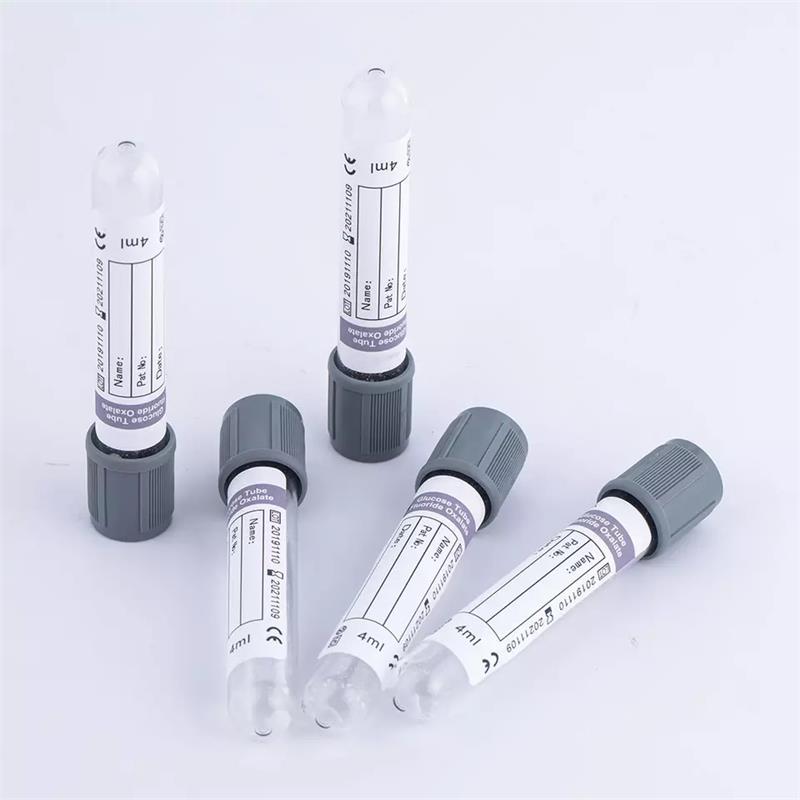
Gray Blood Collection Tube – Sodium Fluoride/Potassium Oxalate Glucose Tube
The gray blood collection tube contains additives such as sodium fluoride + potassium oxalate/sodium fluoride + sodium heparin. Sodium fluoride is a weak anticoagulant that effectively prevents glucose degradation. A mixture of sodium fluoride + potassium oxalate/sodium fluoride + sodium heparin at 4mg can prevent blood from clotting and inhibit sugar decomposition in 1ml of blood for up to 23 days. When using this tube, please ensure slow and thorough inversion for proper mixing.
Sample Type: Whole blood
Applications: Primarily used for glucose testing. Not suitable for urease method urea testing, alkaline phosphatase, and amylase testing.
Apart from the commonly used blood collection tubes mentioned above, there are specialized tubes for specific tests, such as lead element detection tubes, whole blood RNA tubes, plasma protein preservation tubes, ACD tubes, and more. The suitability of these tubes for specific tests depends on the additives present in the tubes and should be considered accordingly.
Distinguishing Between EDTA, Sodium Citrate, Oxalate, and Heparin Anticoagulants

EDTA, sodium citrate, and oxalate all work by binding to calcium ions, the fourth coagulation factor in the blood, preventing the coagulation cascade from occurring and thus exhibiting anticoagulant effects. Since they consume calcium ions, they are not suitable for electrolyte testing in blood.
Heparin, being a natural anticoagulant, does not deplete calcium ions and can be used for electrolyte testing. However, heparin can cause white blood cell aggregation, affecting white blood cell counts and making it unsuitable for routine blood tests.
Sodium fluoride can inhibit the breakdown of blood glucose, making it recommended for blood glucose testing.
Why Are Blood Collection Tubes Color-Coded?
Blood collection tubes come in a variety of colors, and each color represents a specific tube type and its intended use. This color-coding system is essential for healthcare professionals to ensure accurate and reliable test results.
Identification: The color coding simplifies the identification of the tube type and its purpose, reducing the risk of errors during sample collection and processing.
Anticoagulants: Different tubes contain various anticoagulants or clot activators. The color helps in distinguishing tubes with additives like EDTA (purple), heparin (green), sodium citrate (light blue), or no additives (red).
Preventing Contamination: Color-coding ensures that the right tubes are used for specific tests, preventing contamination of samples and ensuring the reliability of results.
Efficiency: Healthcare professionals can quickly select the appropriate tube, streamlining the blood collection process and saving valuable time.
Standardization: The use of standardized color coding enhances laboratory efficiency and minimizes the chances of sample mix-ups.
The Sequence of Blood Collection Tube
1. Clot Activator Tube (Red)
Additive: Clot activator
Function: Promotes blood clotting
Testing: Clinical biochemistry, clinical immunology, cross-matching
2. Serum Separator Tube (Yellow)
Additives: Clot activator, separation gel
Function: Promotes blood clotting; gel separates serum
Testing: Clinical biochemistry, clinical immunology
3. Heparin Anticoagulant Tube (Deep Green)
Additive: Heparin lithium
Function: Inhibits coagulation factors Xa and IIa
Testing: Blood ammonia, hemorheology testing
4. Plasma Separator Tube (Light Green)
Additives: Heparin lithium, separation gel
Function: Inactivates coagulation factor Xa and separates plasma
Testing: Clinical biochemistry
5. Heparin Sodium Anticoagulant Tube (Brown)
Additive: Heparin sodium
Function: Inactivates coagulation factors Xa and IIa
Testing: Clinical biochemistry, cell genetics testing
6. Anticoagulant Tube (Purple)
Additive: EDTA-K2
Function: Chelates calcium ions
Testing: Hematology, cross-matching
7. Oxalate or Ethylenediaminetetraacetic Acid Heparin/Fluoride Anticoagulant Tube (Gray)
Additives: Fluoride, anticoagulant
Function: Inhibits glycolysis
Testing: Glucose testing
8. Coagulation Tube (Light Blue)
Additive: Sodium citrate 1:9
Function: Chelates calcium ions
Testing: Coagulation function, platelet function testing
9. Erythrocyte Sedimentation Rate Tube (Black)
Additive: Sodium citrate 1:4
Function: Chelates calcium ions
Testing: Erythrocyte sedimentation rate



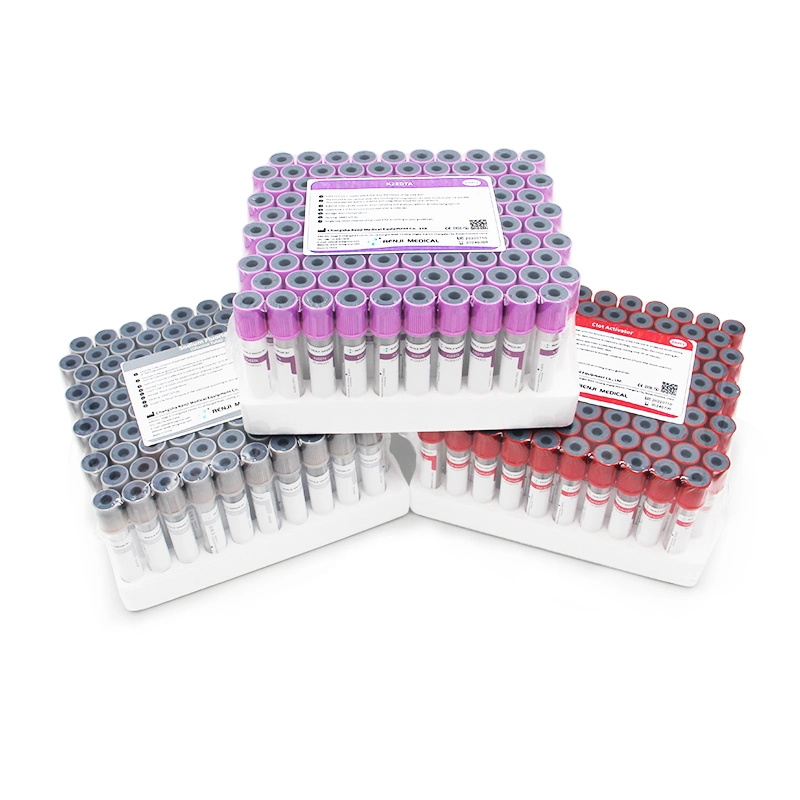

Our team
Why Choose Us
With over 20 years of expertise in medical exports, we specialize in providing a wide range of healthcare products, including a diverse selection of blood collection tubes.
As trusted suppliers and manufacturers of medical consumables, we prioritize quality, precision, and reliability.


Common Questions
Most Popular Questions.
Frequently Asked Questions (FAQ) about Blood Collection Tube
A blood collection tube is a sterile container used to collect and store blood samples for laboratory testing.
They contain various additives that preserve and stabilize blood samples for different types of tests.
Red-top tubes typically contain no additives and are used for collecting serum for chemistry and serology tests.
Serum separator tubes contain a gel that separates serum from other blood components during centrifugation.
Blue-top tubes contain sodium citrate and are used for coagulation studies, such as PT and APTT.
Gray-top tubes contain sodium fluoride and potassium oxalate and are used for glucose testing.
Serum tubes are used for tests that require clotted blood, while plasma tubes are used for tests that require anticoagulated blood.
Yes, some tests require specialized DNA collection tubes, such as EDTA or ACD tubes.
Store tubes at the recommended temperature and avoid exposure to extreme heat or cold.
Yes, using the wrong tube may lead to inaccurate results or sample rejection.
Blood Collection Tube
We would love to hear from you.
Get in touch
Leave us a message
To Get The Latest Medical Consumables Solutions



